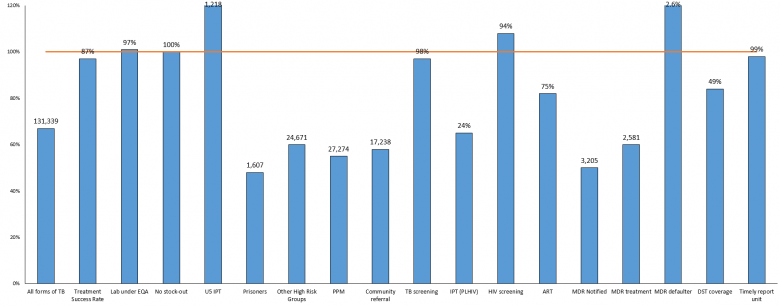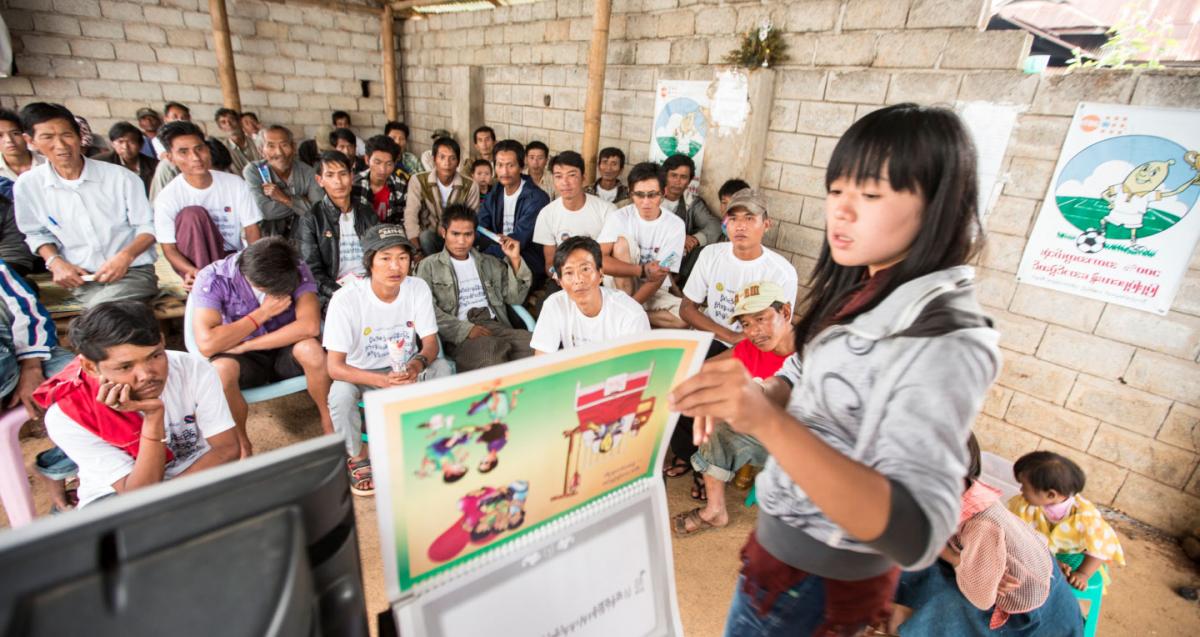
The cumulative results for 2020 are shown as a percentage of the annual target. TB–HIV indicator (collaborative sites) and MDR-TB treatment indicators are funded by GFATM and other donors, while the others are funded by GFATM only.
In 2020, during the COVID-19 pandemic PR-UNOPS was working closely with the public sector service providers and implementing partners to maintain prevention, care and treatment services while undertaking COVID-19 infection control measures so that the interventions were ensured not to be interrupted.
In 2020, 5 out of 18 reportable indicators either meeting or exceeding the annual targets.
During the year, 100,963 (67% of the annual target) TB patients were notified and enrolled on treatment. The treatment success rate was 88 per cent. PR-UNOPS was working closely with the public sector health providers to strengthen COVID-19 fever clinics as a frontline role for TB screening. Through the Global Fund’s support, TB active case finding activities were conducted with portable digital X-rays at Fever Clinics.
External quality assurance samples (quality control slides) from 399of the 460 participating laboratories were sent for assessment due to travel restrictions and lack of transport during the period and 388of the 399 laboratories, or 97 per cent, (101% of target) met the quality control performance criteria.
During the year, a total of 2,122 (200% of the target) children under the age of 5 years who were in contact with TB patients, began isoniazid preventive therapy (IPT). This reflects much improvement in screening and IPT provision in this age group.
A total of 629 (48% of target) of TB cases of all forms were notified among prisoners. During the year, 18,521 (60% of target) cases were notified among high-risk groups.
Some 74 per cent (82% of target) of TB patients with HIV infection had been enrolled on ART during TB treatment by the end of the year. The TB and HIV programmes continue to improve coordination and collaboration between the two programmes to maintain the good achievements on TB-HIV.
In 2020, 2,308 (50% of target) multi-drug resistant (MDR-TB) cases were notified. During the year, 2,357 (60% of target) MDR-TB patients were put on second-line treatment.
During the year, 19,904 (55% of target) of TB patients were referred and/or treated by partners implementing the public-private-mix (PPM) approach. The number of all forms of TB notified by community volunteers through community-based TB care activities, was 16,483 (58% of target).
For Community-based TB care services, although large sessions such as community awareness sessions, mobile team activities were stopped due to the pandemic, one-to-one Health Education session and patient counselling were conducted.
This year, 96 per cent (97% of target) of HIV patients were screened for TB during follow-up visits to the ART centre and decentralized sites.
32.3 per cent (65% of target) of people living with HIV (PLHIV) newly enrolled in HIV care received isoniazid preventive therapy (IPT).
In 2020, 2.6 per cent (51%) of MDR-TB patients who started treatment in the last 12 months, were lost to follow-up during the first 6 months of the treatment.
PR-UNOPS continue to provide transportation allowance and nutrition support to MDR-TB patients via ATM transfer or direct cash payment. TB volunteers are providing Directly Observed Therapy (DOT) supervision either in one-to-one or via tele-communications.
This year, 98 per cent (98%) of reporting units, which comprised 329 townships; 32 public hospitals; and 9 non-governmental organizations, submitted their reports (paper-based) in accordance with the national guidelines. The programme maintained its high performance, and robust recording and reporting system.
The HIV test results of 97 per cent (108% of the target) of notified TB cases were recorded in the TB register, exceeding the programmatic target of 90 per cent.
The drug sensitivity testing (DST) coverage was 59 per cent (84% of target), with nearly half of the registered TB patients tested. GeneXPert testing is currently targeted to TB patients who are mainly from a high-risk group. The National TB Programme is striving to increase DST coverage through improved collaboration with the implementing partners.
In 2020, all reporting units reported no stockout of first-line anti-TB drugs even though there were constraints in transportation and communication during COVID pandemic.


